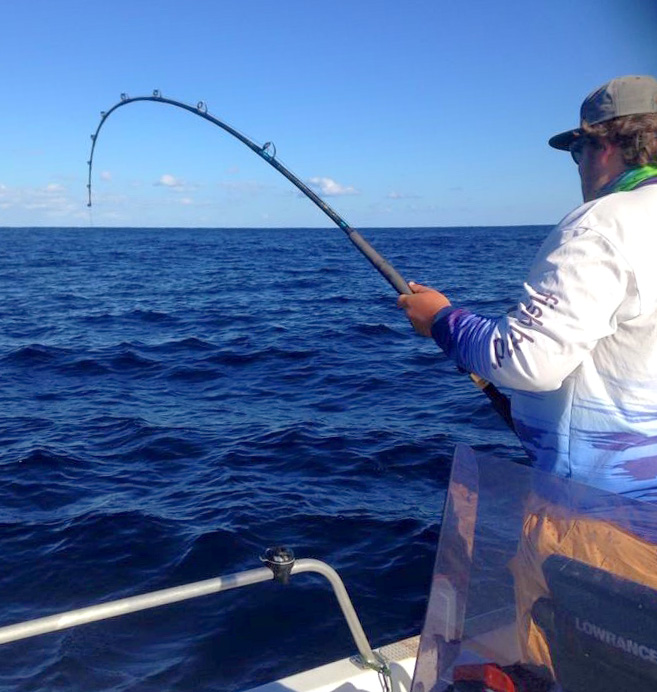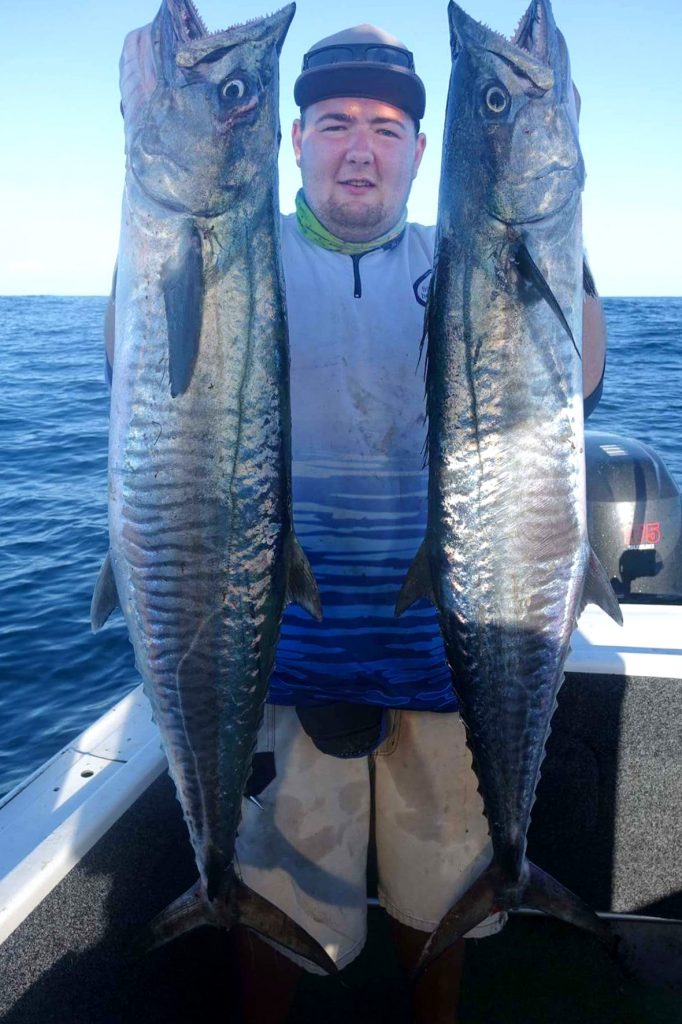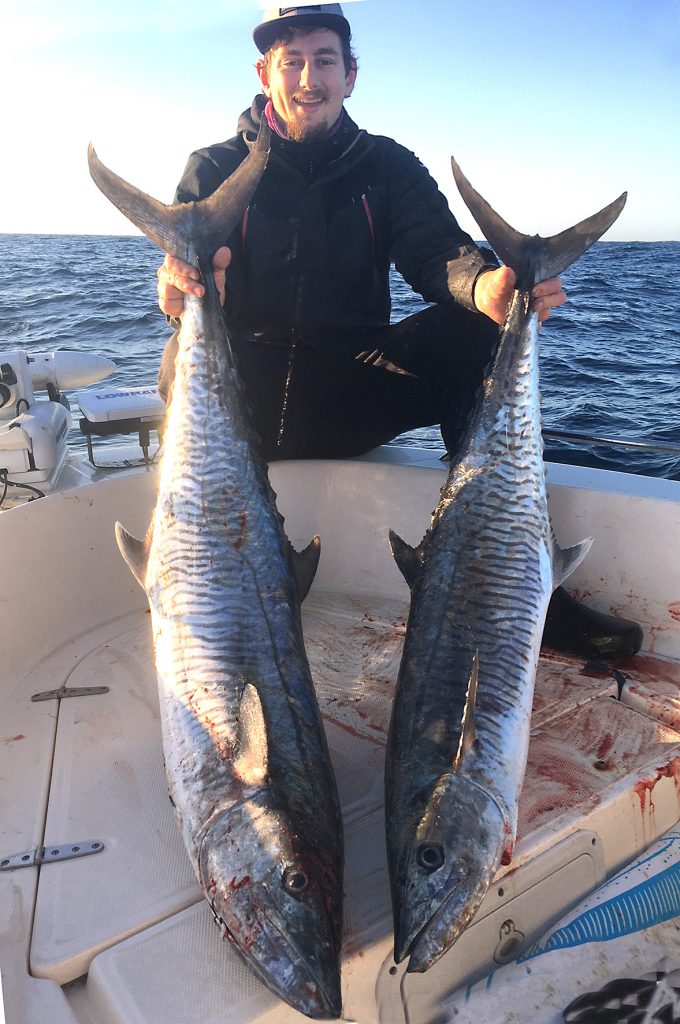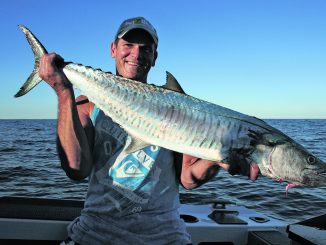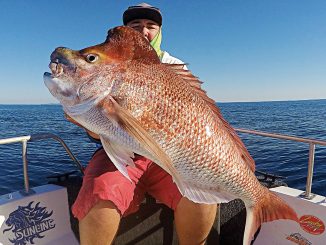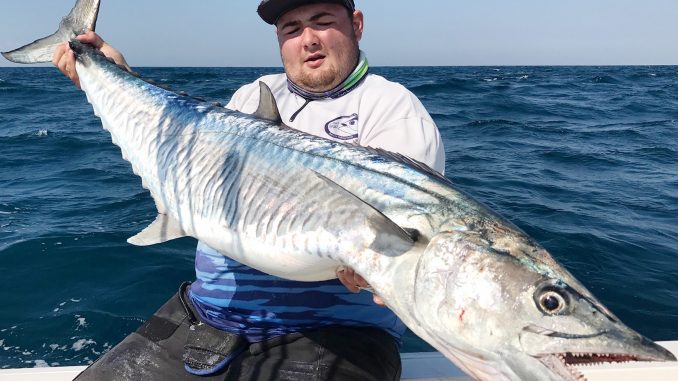
by Kasper Lenigas •
Without a doubt Spanish mackerel are one of my all-time favourite fish to target. Not only are they fast and taste great, but they look mean and have a serious set of choppers that can effortlessly slice any baitfish to pieces. There are many ways to catch Spanish, but trolling for them with live and dead bait is the most effective way.
The specific techniques used for catching Spanish mackerel using baits are slowly becoming a dying art, with more people opting for the easier option of trolling lures, which can certainly catch them on the right days, but is by no means the most effective way to catch a better class or numbers of Spanish.
Trolling baits effectively can take a little time and skill to perfect, but there’s no better feeling than setting out a perfectly righted bait, locating fish on the sounder then turning back and watching your rods in anticipation before they fold over and the drag starts screaming off.
Gearing up
There are many options when it comes to choosing the right setup to target Spanish mackerel on the troll. In my experience the best setup is a lever drag overhead reel in the 20-30 size range with a high gear ratio matched with a 7-8ft long 15-24kg overhead rod. The benefit of using a longer rod is that you have far more manoeuvrability around the boat – these fish can change direction or power off very quickly when boat side and with a longer rod you can eliminate the risk of losing the fish to the prop or hull of the boat.
Long rods also make setting baits apart much easier and with the added length you get much better shock absorption, excellent when absorbing the lunges and violent head shakes during the fight. I find the use of monofilament line on the reel and the absorption from a longer rod create a nicer take up of pressure to set hooks, allowing the fish to hit the bait and turn before the pressure is applied and the hooks set themselves.
High gear ratio reels are great for Spanish mackerel, as mackerel can swim incredibly fast and change direction quickly; the higher ratio makes it easy to keep up with the fish during the fight and maintain pressure. Also high ratio reels make chasing after the fish with the boat much easier, as you can keep pressure on the fish. The combination of a long rod, mono and a high gear ratio reel certainly makes fighting mackerel very easy as you can keep an even pressure very easily throughout the fight, further eliminating the chances of the fish shaking the hooks.
My go-to setup for this style of fishing is a Shimano Tyrnos 20 or 30 reel spooled with 60lb braid and top shotted with 50-100m of 55lb Schneider monofilament on a Wilson Live Fibre M10 10-24kg rod. The reason I use a top shot is so I can change it out to a new top shot when I feel like it and still get enough stretch from the 50-100m of monofilament top shot and lots of line capacity from the braid if I need it.
You can run straight mono if you desire and still have plenty enough line for most fish you encounter. You don’t need to use any fancy or colourful mono. I find the cheaper lines like Schneider to be ideal, as they last long and are very strong and hard-wearing. The Tyrnos and M10 setup is ideal for trolling an array of live and dead baits effectively and will easily catch the majority of fish you encounter.
I’ve caught many fish well over 20kg on this setup, but if you are purposely targeting larger fish in excess of 20kg with big baits, a heavier 37kg combo comes in very handy; it can handle the big baits you are trolling and help shorten the fight time, reducing the likelihood of your fish being eaten by sharks.
I like to run no more than two setups when trolling for Spanish mackerel, but it’s perfectly fine to troll with one setup. The added benefit of running two rods is that you can run two different baits to see what the fish are feeding on. As Spanish mackerel school up it’s not uncommon to encounter multiple hook-ups and I find dealing with two fish much more manageable than three, especially if I fish solo. It’s also much easier to run two baits effectively without tangles; just set them at different distances behind the boat.
How to find them
Spanish mackerel are by far one of the most common pelagics on our reefs and can be found on most inshore and offshore reefs from 10-40m deep in Southern Queensland and northern New South Wales from December through to July. For most of Queensland, Spanish mackerel can be caught year round. The size and numbers vary depending on the time of the year.
Trolling dead and live baits at slower speeds is by far the best way to find and target Spanish mackerel, because these presentations have a natural smell and lifelike action, which is more likely to trigger a response and entice a bite, even if they may not be all that hungry or active. Like most fish you need to find the bait and Spanish mackerel can be on any reef, as long as there is bait or life to hold and attract them to the area.
As you troll baits at slower speeds you can thoroughly cover a reef, so with the added bonus of a sounder it can make it easy to locate the bait and Spanish mackerel so that you can keep trolling over them until they decide to eat. Spanish mackerel will generally hold around the edges of the reef where the current is broken up, as this is where the bait and activity will be holding.
You can find Spanish mackerel sitting off the reef in deeper water feeding on large bait schools or waiting to move up onto the reef at a key bite time, so it can pay to troll off the reef before looping around and trolling back over it again. As far as water goes, you can find them in either green or blue water – they don’t like dirty water.
Live Baits
Live baits are the best bait you can use to catch Spanish mackerel. It can take some time to catch good live baits and keep them alive, but if there are fish on the reef you are fishing, you will find out very quickly if they are there. You can use a whole array of live baits, from small tuna and bonito to yakkas, pike, slimy mackerel, grinners, small queenfish and trevally as well as reef fish like fusiliers, rainbow whiptail and rainbow runners. My motto is if you can rig it and it swims, they will eat it. Rigging live baits is quite easy as well.
For smaller baits I use a small barrel swivel, which I connect my mono leader to. Then off the other end of the swivel I connect 1-2ft of 40-60lb single strand wire trace with a haywire twist, which is then connected to a 4/0-6/0 ‘J’ hook, which is used to pin the baitfish in the nose or mouth. Off the loop connected to the J hook I crimp on a section of 80-90lb kink-resistant stainless steel cable; this allows the bait to move easily and you can catch multiple fish off one rig, as the wire won’t kink and damage as easily. To the end of the multi-strand cable I crimp on a size 1 or 1/0 treble, which I pin two thirds of the way down in the back of the live bait. Spanish mackerel have incredibly sharp teeth and you must use a good amount of wire leader to prevent bite-offs.
For larger baits over 1ft long to target larger Spanish mackerel I will use a 2-3ft 70-80lb single strand wire leader and a larger 6/0-8/0 J hook to pin the fish in the mouth. Instead of crimping on one 1/0-3/0 treble hook with 90lb kink-resistant stainless cable I’ll crimp on another piece of cable off the loop to the first treble hook so I have two treble hooks to pin in along the bait, giving me a better chance of hooking the fish.
When making up live bait rigs I make up a whole heap of different ones to suit the different sizes and types of live baits I use and keep them separated in a tackle box. The reason I like to use single strand in front of the live bait is that it’s cheaper to use than cable and I believe it’s harder for mackerel to see. At the end of the day live bait rigs are a disposable item, so the cheaper you make them, the better.
When running live baits I like to run my strike drag around 3-5kg, as it is very easy to set the hooks into a Spanish mackerel’s mouth as they come flying through, snipping the bait in half and usually getting caught on a treble in process.
When setting out live baits it’s more than fine to run two live baits on the surface. If you want to get serious, you can run one down deep (10-15m) on a downrigger and one on the surface; this will cover more of the water column, giving you a better chance of catching a fish, as Spanish will sit deeper in the water column during the day. When setting livies back I will run them at different distances so they don’t tangle. I set one 30m behind the boat and the other 40-50m.
I find 1-2 knots and knocking the boat in and out of gear to be the most effective way of trolling, as you don’t want the bait spinning. If the bait is spinning, you may need to slow down the trolling speed. For tuna, bonito and larger fish you may need to bump the speed up to 2-3 knots to keep them swimming, so you have direct contact with your bait; this increases the hook-up rate.
Using larger baits can be hard, because you can’t run them with small baits that easily; they can be hard to come by some days and harder to keep alive if you don’t have tuna tubes. Some days I will catch big live baits at a spot I’m fishing for Spanish and instantly rig them up and send them out. That bit of effort is the only way you will catch the quality fish some days.
Dead baits
Dead baits may not be as effective as live baits some days, but they are a very good alternative on days when you’re not able to catch good quality live baits. With any bait fishing the old saying ‘fresh is best’ certainly comes into play – the fresher the bait, the better it swims and looks, which greatly increases your chances of a bite. When collecting live baits it’s always a good idea to catch a heap when they are around, keep what you need for the day’s fishing alive and put on ice then vac seal and freeze them when you get home to use as dead baits later on. The baits you catch yourself are better quality and cheaper than buying your baits from a fish shop.
There is a huge array of dead baits that you can use to troll with and if you can swim it, mackerel will eat it. The pick of the baits are garfish, pike, sauries, tailor, slimies, yakkas and bonito, but you can also use small mac tuna, school mackerel, fusiliers, silver trevally and grinners. Some days they will eat anything and some days if they are shy, seeing something different can trigger a bite.
Rigging the baits correctly can be hard, because you must soften the bait, rig it on the hooks the right way and tie it off, securing it to the hook rig so it swims correctly; if the bait spins you won’t catch many fish. Learning the skill to rigging baits properly and getting them to swim can be frustrating and take time but once you get it right and look at the bait swimming seductively next to the boat like a real fish, you know a Spanish mackerel is going to nail it when you troll it. Rigging up the bait properly is key to success, you can go out and buy premade rigs but making them is cheaper and they work better.
For smaller baits like garfish, pike, yakka, slimies, smaller tailor and sauries I like to use set of 3-4 ganged Mustard 7766D tarpon hooks, depending on the bait size I will use a 7/0 or 8/0 set of gangs. I leave the hook eye straight on the nose hook and for the trailing hooks I bend the eyes up a bit with a vice and pair of vice grips, this is so the hooks sit better in the bait once its rigged. To open the eyes of the hooks I use a pair of side cutter as they open the hook eye up nicely without damaging/fatiguing the metal too much.
On the nose hook I will add a small amount of net lead and crimp it on to help keel the bait and help it swim. I also use a 20cm length of copper wire and wrap it around the shaft of the hook near the eye 4-5 times and push it through the eye of the hook to hold it on. The copper wire is use to stitch and secure the bait to the front hook.
Like live bait rigs I like to use a 1-2ft length of 50-60lb single strand wire leader attached to the front hook to prevent mackerel bite offs and sometimes I will feed a squid skirt on the wire leader and slide it over the head of the bait so it acts as a bait attractor and to stop the bait washing and the eyes bulging on smaller baits.
For larger baits like tuna, large tailor, bonito, school mackerel and anything else over a foot long I will use a gang of 4-5 10/0 or 11/0 7766D tarpon hooks and bend all the eyes up including the nose hook as the tow point on the nose hook will naturally pull the nose of the bait down making the larger baits swim far better. I add the copper wire to the nose hook as well so I can secure the head and nose of the bait to the front hook. I also add a net lead to the front hook and second hook; this will assist in helping the bait swim and allow it to swim a little deeper. I then attach a 2-3ft length of 70-80lb single strand wire to the rig. I don’t use squid skirts on large bait rigs but if you want to you can use one.
The bait must be thoroughly defrosted before rigging. When rigging the bait I first soften the bait by softly squeezing the body and moving its tail in a snakelike motion. I then feed the copper wire up through the bottom and top jaw of the bait then place in the first hook on the underside of the fish and push it in until the hook eyelet lines up with the nose of the bait. I then close the bait’s mouth, tying the copper off and securing it to the front hook. I then line up the other hooks and push the bait back and place the hooks in along the belly, starting with the second hook and working my way along. The bait should sit straight and have some movement if you wiggle it while holding the wire leader.
When trolling dead baits I like to run a fair bit of strike drag – 5-8kg is more than enough and you’ll have more hook points to set. Also the hooks are larger, so it takes a bit more force. You’ll miss the odd hook-up – mackerel must bite the bait in half to find the hooks – but the burst of bait when they hit and miss can cause a frenzy and other mackerel may jump straight on.
The trolling speed for dead baits is 3-4 knots and you can troll big or small baits together. I like to run my large bait 30-40m behind the boat and the small one 50-60m. Spanish mackerel can be boat-shy some days, so the further you set the baits back, the better; it can also allow the bait to swim a little deeper.
The fight
Unless you’re using a deck winch or wire line, you won’t stop a mackerel on its initial run, but that’s the one reason I love catching these fish. Their first run is so fast! Who doesn’t love the sound of a screaming reel? Once you’ve got the bite and hooked the fish, it’s important to keep the boat motoring forward and clear the other rod if it hasn’t gone off. Once the fish has settled keep the boat slowly moving forward and pump and wind the fish; it should be getting towed by the boat once it has stopped running.
If it’s a big fish, slowly turn up on it and wind the line in as quickly as possible to keep pressure on the fish until you are on top of it and motoring away from it to keep it coming with the boat. Once the fish is moving with the boat take your time bringing it in gaffing range, as they can dart off on shorter runs. Once the fish is in gaffing range place a gaff shot in around its head to avoid damaging the flesh. Gaffing a fish in the body can be very dangerous as the fish can thrash about swinging a serious set or choppers around with a few sets of hooks.
Mackerel are a fragile pelagic and don’t handle being caught and released, and a high percentage die. If you wish to target them, it’s important that you do the right thing by the fish and keep it. Once bled and iced, Spanish mackerel are a superb eating fish and their flesh is fine to freeze and eat at a later date. There is a rare chance of ciguatera poisoning from large fish, but you would have to be very unlucky to get it, as cases are very rare. If you’re worried, eat smaller portions in one sitting.
I hope this information gets you interested in targeting these awesome speedsters, helps you catch a feed for you and your family and possibly land a trophy specimen. Until next time, stay safe and good luck.




